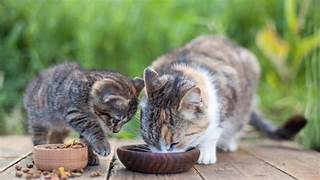
Feeding Multiple Pets: How to Keep Meals Fair.
Feeding multiple pets can be challenging, especially when they have different dietary needs, personalities, or medical conditions. Ensuring fair access to food, preventing conflicts, and managing individual nutrition requires planning, structure, and the right tools. This guide explores practical strategies to create a peaceful, healthy, and balanced mealtime routine in multi-pet households.
🐶 Pet Star
51 min read · 4, Jul 2025

Introduction
Feeding multiple pets under one roof may seem like a simple chore, but it often becomes a complex task. Whether you're managing dogs and cats, pets with food allergies, or animals with vastly different personalities and energy needs, achieving a harmonious feeding routine requires effort. Unchecked, mealtime can cause competition, food stealing, obesity, stress, and even aggression.
In this article, we explore the reasons why structured feeding is essential in multi-pet households, the challenges owners face, and the actionable strategies to make mealtime peaceful, fair, and healthy for every furry member of your family.
Understanding the Feeding Challenges in Multi-Pet Homes
Feeding pets in a multi-animal household is much more than just placing multiple bowls on the floor. Each pet is a unique individual with its own metabolism, preferences, sensitivities, and instincts. Below are the primary challenges associated with feeding multiple pets:
1. Food Aggression and Competition
Some pets become possessive over food and may growl, snap, or push others away. This can lead to fights or create anxiety for more submissive pets who might not get enough food.
2. Resource Guarding
Dogs and cats are territorial. When food becomes a contested resource, animals may begin guarding their bowls, leading to stress and behavioral problems.
3. Different Dietary Needs
A puppy needs high-calorie food; a senior dog requires lower-fat nutrition. One cat may be on a kidney diet, while another eats regular kibble. Managing different diets requires meal-time separation.
4. Speed Eaters and Grazers
Some pets gobble down food within seconds, while others like to nibble slowly throughout the day. Speed eaters often finish their bowl and attempt to eat others' food, leading to overeating and unequal nutrition.
5. Obesity and Underfeeding
In unmonitored environments, dominant pets may overeat, while submissive ones go hungry. This imbalance can lead to health issues, such as obesity, malnutrition, diabetes, and pancreatitis.
Key Strategies for Fair Feeding
Here’s how to successfully manage feeding time with multiple pets, ensuring fairness, health, and harmony.
1. Establish a Routine
Pets thrive on routine. Feeding them at the same times daily not only regulates their digestive system but also helps prevent begging and stress. Set fixed feeding windows and stick to them, even on weekends.
2. Feed Separately
The most effective way to prevent food aggression and stealing is to feed pets in different areas:
- Assign separate rooms or use baby gates.
- Crate train dogs so they associate crates with mealtime.
- Use vertical feeding spaces (like shelves or countertops) for cats if dogs are present.
3. Use Feeding Stations or Barriers
Special feeding stations with barriers can restrict access to food. Pet technology now includes microchip-activated feeders that open only for the assigned pet, which is great for cats with dietary restrictions or medications in their food.
4. Control Free Feeding
Avoid leaving food out all day. Scheduled feeding ensures you can monitor how much each pet eats. For pets that prefer grazing, consider using a food-dispensing toy or a slow feeder to regulate intake.
5. Monitor Each Pet’s Intake
Regularly observe how much each pet eats. Use a kitchen scale to measure food and track consumption. This can help detect early signs of illness, as changes in appetite are often the first indicators.
6. Use Slow Feeders and Puzzle Bowls
For pets that eat too fast, use puzzle feeders or slow-feed bowls. These devices not only slow down consumption but also provide mental stimulation and prevent bloat.
7. Train Pets for Mealtime Manners
Basic obedience like "sit," "stay," and "wait" can be powerful tools during feeding. Train pets to wait calmly while you prepare and distribute food. This reduces chaos and reinforces hierarchy and patience.
8. Assign Feeding Order
Establish a consistent feeding order, particularly in dog groups. Often, it helps to feed the most dominant or excitable dog first and the calmer ones next. With cats, feeding simultaneously but separately works best.
9. Separate Water Bowls
While food should be personalized, water should always be shared and abundant. However, ensure bowls are placed in multiple spots to reduce crowding and tension.
10. Special Needs and Medical Diets
Pets with chronic illnesses or on prescription diets should always be fed separately. Mixing foods can be dangerous. Always consult your vet to tailor nutrition for pets with health issues.
Tools and Gadgets for Multi-Pet Feeding Success
Modern technology and pet accessories have made multi-pet feeding easier than ever:
- Microchip Feeders (SureFeed, etc.): Prevent food stealing by only opening for the pet’s chip/tag.
- Slow Feed Bowls: Prevent speed eaters from finishing too quickly.
- Crates and Pens: Offer individual eating space.
- Elevated Feeders: Useful for senior pets or pets with arthritis.
- Timer-Enabled Automatic Feeders: Ideal for when owners aren’t home to manage feeding.
Behavioral Considerations
Feeding issues often stem from behavioral imbalances. Dominance, anxiety, and territorial aggression can all influence how pets behave around food. Here's how to manage the behavioral aspect:
- Positive Reinforcement: Reward good mealtime behavior.
- Desensitization Training: Slowly acclimate pets to eating near each other.
- Behaviorist Help: In extreme cases, a professional pet behaviorist can help restore balance.
Feeding Multiple Pets of Different Species
In homes with both cats and dogs, unique challenges arise. Dog food and cat food are nutritionally different. Cats need taurine and higher protein levels; dogs can become sick from too much fat or certain nutrients in cat food.
- Feed Separately: Always feed dogs and cats in different rooms or on different levels.
- Elevated Surfaces for Cats: Use cat trees or shelves.
- Block Access: Use baby gates or doors with latches to keep dogs out of cat feeding zones.
Feeding multiple pets in a single household is a task that may appear straightforward but is, in reality, layered with complexity and subtle behavioral dynamics that pet owners must navigate to ensure harmony, health, and fairness. Whether managing several dogs, cats, or a mix of species, the challenge of equitable feeding stems from numerous factors like dietary needs, personality traits, feeding speed, and territorial instincts. Unlike the simplicity of feeding a single pet, feeding multiple pets often means managing a range of issues such as food aggression, resource guarding, differing nutritional requirements, and the fast-eater vs. grazer dilemma. For instance, a young and energetic puppy may require calorie-dense food rich in protein and fat, while a senior dog needs a lighter, joint-supporting diet, and a cat with kidney issues may need a specialized prescription formula; feeding them together in the same space can lead to food stealing, overfeeding, or a pet missing out on necessary nutrition. Moreover, pets that are naturally dominant or anxious may try to guard their food, while submissive or shy animals often retreat and eat less than needed, leading to long-term health imbalances such as obesity or malnutrition. Therefore, one of the most effective strategies is to develop a consistent, structured routine where all pets are fed at set times in designated spaces. Scheduled feeding eliminates the temptation of food theft and allows owners to monitor exactly how much each pet eats, which is essential for catching early signs of illness, as changes in appetite can signal underlying health problems. Feeding pets in separate rooms or using barriers like baby gates or crates helps eliminate competition, while elevated feeding spots are ideal for cats in homes with dogs. For those who want a tech-savvy approach, microchip-activated feeders have become invaluable in ensuring only the intended pet can access a specific bowl, especially useful when one pet requires medication or a restricted diet. Similarly, puzzle feeders and slow-feed bowls are a must-have for pets that gobble food too quickly, as they not only slow down consumption but also provide enrichment and mental stimulation. Additionally, feeding in a calm, quiet environment away from household foot traffic can minimize stress, while training pets to wait patiently with commands like “sit,” “stay,” and “leave it” can establish mealtime discipline. It’s also essential to avoid free-feeding, especially in multi-pet households, as it encourages overeating in dominant pets and deprives shy or slow eaters of their share; structured mealtimes reinforce a healthy feeding culture and make it easier to track consumption. In cases where dogs and cats cohabit, care must be taken since dog food and cat food are formulated differently; cats require taurine and high-protein diets, while dog food often lacks key nutrients for felines, and vice versa, a dog consuming cat food may ingest excessive fat or calories, leading to weight gain or digestive issues. The use of vertical feeding spaces like shelves or cat trees can help separate cat food zones from dogs, and baby gates or specially designed pet doors can further restrict access. For households where one pet is on a medical or prescription diet, such as for allergies, diabetes, or kidney disease, it becomes non-negotiable to enforce feeding separation, as even a small bite of the wrong food can lead to severe complications. It’s worth noting that feeding order also plays a role in harmony—some experts recommend feeding dominant pets first to reduce anxiety or, in some cases, feeding simultaneously but with physical distance to prevent disputes. When it comes to monitoring food intake, using a digital kitchen scale to measure food portions ensures consistency, while recording food consumption over days or weeks can help detect anomalies in eating habits. Another often overlooked factor is the emotional well-being of pets during mealtime; pets that feel rushed, threatened, or anxious may develop aversions to food or act out through undesirable behavior, and correcting this requires a calm environment and positive reinforcement. Multiple water stations are also important in multi-pet homes, as pets should never feel the need to compete for hydration, and water bowls should be cleaned and refilled daily to encourage consumption. If food aggression or territorial behavior persists despite environmental and procedural changes, consulting a veterinarian or certified animal behaviorist is a wise move, as underlying medical or psychological causes may need addressing. Behavioral training paired with environmental management can reshape food-related aggression or anxiety over time. From a gadget perspective, today’s pet market offers several advanced tools to assist with fair feeding—automatic feeders with timers, smart bowls with app-connected tracking, elevated feeders for large or arthritic pets, and feeding mats that prevent bowl skidding and mess. Pet owners should view feeding time not just as nourishment but also as a time of training, observation, and bonding. It is during these moments that pets learn trust, patience, and structure. In summary, feeding multiple pets fairly requires a blend of strategy, consistency, technological support, and an understanding of animal behavior. When managed effectively, mealtime becomes a stress-free and nurturing part of daily life rather than a battleground of competition and chaos. Owners must remember that fairness does not always mean feeding the same food or at the same pace—it means meeting each pet’s unique nutritional and emotional needs in a way that promotes well-being, safety, and balance within the household. Ultimately, a well-managed feeding environment results in healthier pets, fewer behavioral issues, and a more harmonious home.
Feeding multiple pets in a household may initially seem like a manageable chore, but in practice, it introduces a web of challenges that go far beyond filling bowls. Every pet has unique needs based on their species, breed, age, temperament, and medical conditions, which can turn feeding time into a complex balancing act requiring structure, observation, and strategy. When animals share a living space—especially in cases of multiple dogs, multiple cats, or a combination of both—they may have conflicting behaviors such as food aggression, guarding tendencies, or speed eating, all of which can lead to stress, fights, malnutrition, or obesity if not addressed. Some pets may require calorie-dense food due to high energy levels or youth, while others, particularly seniors or those with chronic conditions like diabetes or kidney disease, need specialized diets with limited ingredients, lower fat, or prescription-only nutrients. Mixing these feeding needs without proper structure can result in one pet consuming another’s food, leading to imbalanced nutrition or even life-threatening consequences. In addition, mealtime often becomes a competition where dominant pets eat quickly and bully others away from their bowls, while more submissive or anxious animals avoid the chaos altogether and go hungry. To maintain fairness, scheduled feeding routines are essential. Feeding pets at consistent times, ideally twice a day, helps establish predictability, reduces anxiety, and curtails the problem of food being left out and stolen later. Free-feeding or leaving kibble in a shared bowl throughout the day is discouraged in multi-pet homes because it makes it impossible to monitor how much each pet is eating and invites greedy behavior. Instead, owners should assign each pet a separate space for meals—this could be in different rooms, behind baby gates, or in crates for dogs that are already crate-trained. Cats can be fed on elevated surfaces such as shelves or counters that are inaccessible to dogs. This physical separation not only eliminates competition but also reduces the risk of stress and digestive issues linked to rushed eating. For households that cannot offer physical barriers, there are modern tools like microchip-activated feeders that open only when the assigned pet approaches, making it ideal for cats on special diets or those who eat more slowly. Feeding each pet in a calm, controlled environment is just as important as what they are fed; a chaotic feeding scene can heighten aggression or anxiety, especially in rescue animals or those with past trauma. To manage pets that eat too fast—often leading to choking, vomiting, or even bloat in dogs—slow-feed bowls or puzzle feeders are effective tools that encourage slower eating while providing mental stimulation. Meanwhile, pets that graze or eat slowly may benefit from timed meals where food is available only for 15 to 20 minutes and then taken away, training them to eat promptly and reducing the risk of another pet stealing leftovers. Monitoring each pet’s portion and appetite is critical to their long-term health; even minor changes in eating habits can be early signs of health issues such as dental pain, gastrointestinal problems, or even emotional stress. Using a kitchen scale to portion meals accurately and keeping a feeding log can help in spotting trends and maintaining consistency. Training also plays a vital role in multi-pet feeding success. Teaching dogs and even cats basic commands like “sit,” “stay,” and “wait” can add structure to feeding time and reduce disorder. In families where food aggression exists, counter-conditioning and desensitization training, often guided by a certified animal behaviorist, can help reduce guarding and reactivity. In situations where behavioral problems persist despite routine and training, professional intervention becomes necessary to prevent escalation. Another layer of complexity arises in multi-species households. Cats and dogs, for example, have very different nutritional requirements—cats are obligate carnivores needing taurine, arginine, and higher protein levels, while dogs are omnivores with broader dietary flexibility. Feeding a dog cat food can lead to obesity and pancreatitis due to its high fat and protein content, while a cat eating dog food may suffer deficiencies in key amino acids, risking heart or vision issues. Therefore, owners must ensure species-specific food is provided and protected from cross-access. Vertical feeding for cats is the most effective way to create species boundaries, and specialized cat doors or selective entry systems can ensure only the right animal reaches the food. Water bowls, unlike food bowls, should be accessible to all and placed in multiple quiet spots throughout the home to prevent crowding and ensure hydration. For households with pets on medication, owners must take extra care to administer pills or supplements during or after feeding in a secure environment where no other animal can access medicated food. Consistency in feeding order can also contribute to peace—many trainers recommend feeding the most excitable or dominant pet first to reduce anxiety, while others may choose simultaneous feeding for all pets to maintain neutrality. Whichever system is used, predictability is key. Thankfully, technology has made feeding management easier—automatic feeders, food timers, portion controllers, and even mobile apps now allow pet parents to schedule, track, and control mealtime remotely. For pet owners away during the day, timed feeders can ensure no pet goes hungry or eats too much. In conclusion, feeding multiple pets fairly isn’t just about logistics—it’s about understanding the emotional, physical, and behavioral nuances of each animal and designing a meal routine that respects their individuality while promoting a peaceful co-existence. With the right combination of physical setup, feeding tools, consistent scheduling, and training, pet parents can transform what might feel like a chaotic daily routine into a peaceful ritual that enhances their pets’ well-being and strengthens the human-animal bond. Fair feeding isn’t about equality in portions or type of food—it’s about equitable access, tailored nutrition, and emotional safety. Whether you’re managing two cats, three dogs, or a mixed-species household, fairness at mealtime is one of the most impactful forms of love and care you can provide to your furry family members.
Conclusion
Feeding multiple pets fairly is not about being strict—it's about being smart. Establishing a routine, personalizing diets, preventing conflict, and using tools like microchip feeders or training can make feeding time calm and effective. With consistent effort, each pet will feel secure, satisfied, and cared for.
Fair feeding leads to better health outcomes, fewer behavior issues, and improved bonding between pets and their owners. Whether you’re juggling two cats or a household of dogs and cats, implementing structured mealtime practices can transform your pet-care routine for the better.
Q&A Section
Q1 :- How can I stop one pet from eating another pet’s food?
Ans:- Feed pets in separate rooms or use microchip-activated feeders that only open for a specific pet. Training, crate feeding, or elevated cat feeding zones can also help prevent access to others’ meals.
Q2 :- What if one pet eats fast and another eats slowly?
Ans:- Use slow feeders for the fast eater and schedule timed, separate meals for the grazer. Remove food after 15-20 minutes to maintain structure.
Q3 :- Can I feed all my pets the same food to simplify things?
Ans:- Not recommended. Pets have different nutritional needs based on age, breed, species, and health conditions. Always consult your vet before offering the same diet to all pets.
Q4 :- Is free-feeding a bad idea in multi-pet homes?
Ans:- Yes, in most cases. Free-feeding can lead to overeating by dominant pets and underfeeding for submissive ones. Structured mealtimes are safer and healthier.
Q5 :- How do I know if my pet is getting enough food?
Ans:- Measure their food, monitor weight, and check body condition regularly. Signs like weight loss, lethargy, or food guarding may indicate issues.
Similar Articles
Find more relatable content in similar Articles

Virtual Vet Visits: Are Online Consultations Reliable?..
As pet healthcare embraces dig.. Read More

Social Media for Pets: Turning Your Pet into a Digital..
From playful puppies to charis.. Read More

Composting Pet Waste: A Greener Way to Clean Up...
As pet ownership continues to .. Read More

Pets and Mental Health: The Science Behind Emotional H..
Discover the profound impact o.. Read More
Explore Other Categories
© 2024 Copyrights by rPets. All Rights Reserved.